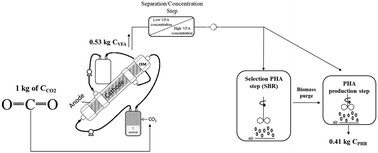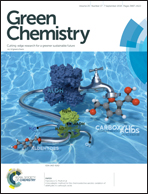Bio-electrorecycling of carbon dioxide into bioplastics
Abstract
The rise of carbon dioxide (CO2) emissions and the accumulation of non-biodegradable plastics in the environment are leading to an environmental crisis. Thus, the bio-electro recycling of recalcitrant CO2 as feedstock to produce bioplastics could be an interesting solution to explore. In this work, a bioelectrochemical reactor was used to carry out microbial electrosynthesis (MES) of volatile fatty acids (VFAs) from CO2 and then, those VFAs were used to produce polyhydroxybutyrate (PHB) by using a pre-selected mixed microbial culture (MMC). During MES (cathode potential at −0.8 V vs. SHE), CO2 fixation efficiency, i.e. carbon (C) transferred to final products was of 73% CCO2, with a final values of 43.7 and 103 mmol of C produced for acetate and butyrate. The VFAs obtained were extracted and concentrated by liquid membrane extraction getting a broth with a C concentration of approximately 400 mmol C L−1 (∼65% butyrate), to be used as feeding for PHA producing bacteria. During the PHA accumulation a maximum of 74.4 ± 0 g PHA per 100 g VSS was obtained with a PHA yield (Ytot) of 0.77 ± 0.18 mmol CPHA mmol−1 Cfed. The process efficiency calculated taking into account the PHA yield on C inlet as CO2 was of 0.50 ± 0.07 mmol CPHA mmol−1 CCO2. In terms of C conversion, 0.41 kg of carbon as PHA were obtained per 1 kg of carbon as CCO2 inlet to the entire system. These results establish a sustainable way to convert a greenhouse gas as CO2 into environmental friendly bioplastics.



 Please wait while we load your content...
Please wait while we load your content...